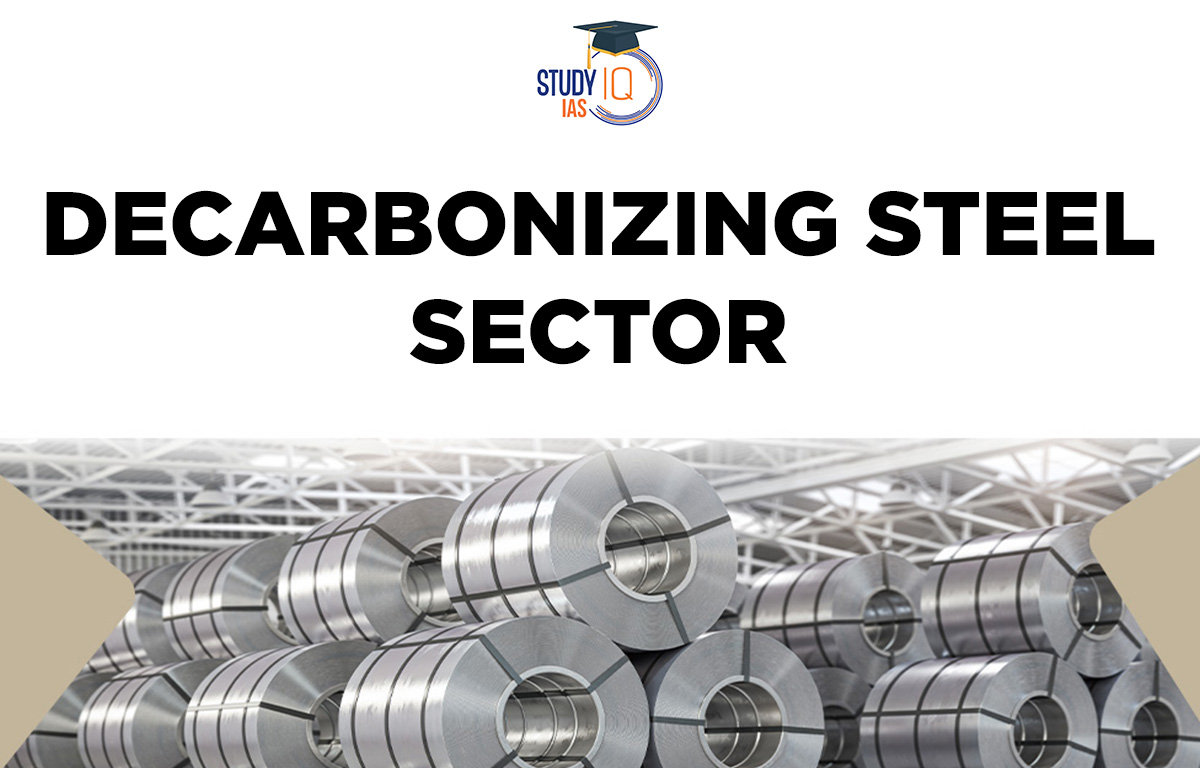Table of Contents
Context: Decarbonisation of steel sector is an integral part of the India’s ability to achieve its climate goal. A recent study has tried to minimize use of carbon in steel making.
More on the News
- To produce one ton of steel, 1.8 ton of carbon dioxide is released. India being second largest producer of steel in the world has one of the largest carbon footprints.
- Existing procedure: To separate iron from iron oxide, coke is heated with the ore. The resulting chemical reaction separates carbon and produces strong steel.
- This process accounts for almost 90% of the carbon footprint of steelmaking.
- The solution:
- Using hydrogen: Scientists have thought of using hydrogen in place of carbon to separate iron from the ore. However, this reaction is very slow.
- This is because, removal of oxygen results in small pores. When hydrogen is the reactant, water is formed while hydrogen reacts with oxide, which becomes trapped inside the pores.
- This process reoxidises the iron and considerably slows oxygen removal.
- Researchers have suggested creating narrow channels on the mineral for water to drain, ensuring that hydrogen enters them and continue removing oxygen.
- However, this procedure has several challenges, such as reduction kinetics and the high cost of hydrogen reactants.

Global Carbon footprint in Steel sector
- Studies have shown that, steel sector contributes to 8% of global carbon emissions.
- Coal-fired furnaces: More than 75% of steel currently produced in the world is made in coal-fired furnaces, which emits large amounts of carbon dioxide into the atmosphere.
- Heat energy: Furnaces must be heated above 1000 degree Celsius for manufacturing steel. The energy needed to heat the furnaces is usually through electric current, which further increased energy demand.
What is Decarbonization?
- Decarbonization is a process of sustainably reducing and compensating the emissions of carbon dioxide (CO₂). The goal is to create a carbon-free economy.
- Importance of decarbonization of steel sector:
- Achieve climate goals: Experts have said that emissions from steel must be reduced by 50% by 2050 and then continue to fall, to meet the world’s climate goals.
- Reduce dependency on fossil fuels: Decarbonisation will help reduce the dependency of steel industry on fossil fuels. This will ensure the rise of alternative sources.
- Reduce import bill: Majority of coal used in iron smelting is imported into countries such as India and Japan. Reducing use of coal will also reduce import bill.
- Sustainability: The existing process of steel production is too dependent on non-renewable energy sources. Decarbonisation will make the process more sustainable and long-lasting.
Reducing Carbon Emission from Steel Sector
- Carbon capture and utilization technology: There are many types of equipment that can capture the CO2 released and store them without emitting back. This can reduce carbon footprint.
- Steel recycling: Instead of mining iron and later converting into steel, scrap can be smelted and molded to manufacture steel. This reduces carbon footprint considerably.
- Hydrogen fuel: Using green/blue hydrogen in furnace produces only water as by-product. This process is completely free of CO₂ emissions.
- Renewable energy furnaces: Instead of coal furnaces, electric energy furnaces can be used. These have to be run on renewable energy to make the process carbon-free.
- Syngas: It is a product of coal gasification. Syngas can be used more efficiently than direct combustion of the original fuel, which is coal.
Green Steel:
- Green steel is a type of steel that is manufactured without using any fossil fuels. It uses alternative energy sources such as hydrogen, coal gasification, or electricity in production.
Challenges involved in Decarbonization
- High cost: The cost of shifting to carbon-free technologies is very high, leading to increase in cost of steel. This can increase burden on consumers.
- Knowledge gaps: Lack of access to relevant information is important barrier for implementing decarbonizing process in steel-making.
- Lack of urgency: Countries have not announced any urgency to implement decarbonization measures for steel sector. This is a major barrier in promoting green technologies.
Efforts in India to Decarbonize Steel Sector
- National Green Hydrogen Mission: The mission aims to increase production of green hydrogen, which has zero-carbon footprint.
- The eco-friendly hydrogen can be used in manufacture of steel instead of coke.
- Motor Vehicles (Registration and Functions of Vehicles Scrapping Facility) Rules: Ministry of Road transport has announced a detailed scrappage policy for old motor vehicles. The policy is expected to increase availability of scrap in the steel sector.
- Steel Scrap Recycling Policy, 2019: This policy aims to produce steel from recycled scrap, without mining or through manufacturing new ones.
- Perform, Achieve and Trade (PAT) scheme: Implemented under National Mission for Enhanced Energy Efficiency, it incentivizes steel industry to reduce energy consumption, including that of coal.
- The National Solar Mission: It promotes the use of solar energy in furnaces and aims to reduce emissions in the steel industry.
Way Forward
- Overcoming the challenges related to decarbonization requires the contribution and cooperation of all industry stakeholders, including the government, steel companies and also the consumers.
- A lot of handholding is required for companies to implement green technologies that reduce emissions and also keep their operation costs minimum.


 Serious Fraud Investigation Office (SFIO...
Serious Fraud Investigation Office (SFIO...
 Article 142 of Indian Constitution, Sign...
Article 142 of Indian Constitution, Sign...
 Pakistan-Occupied Kashmir (PoK): History...
Pakistan-Occupied Kashmir (PoK): History...





















